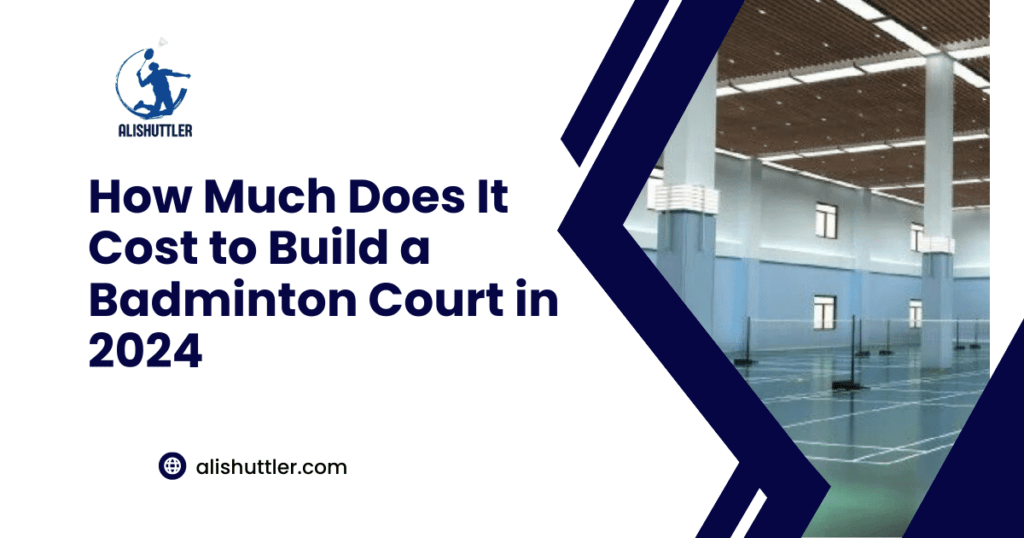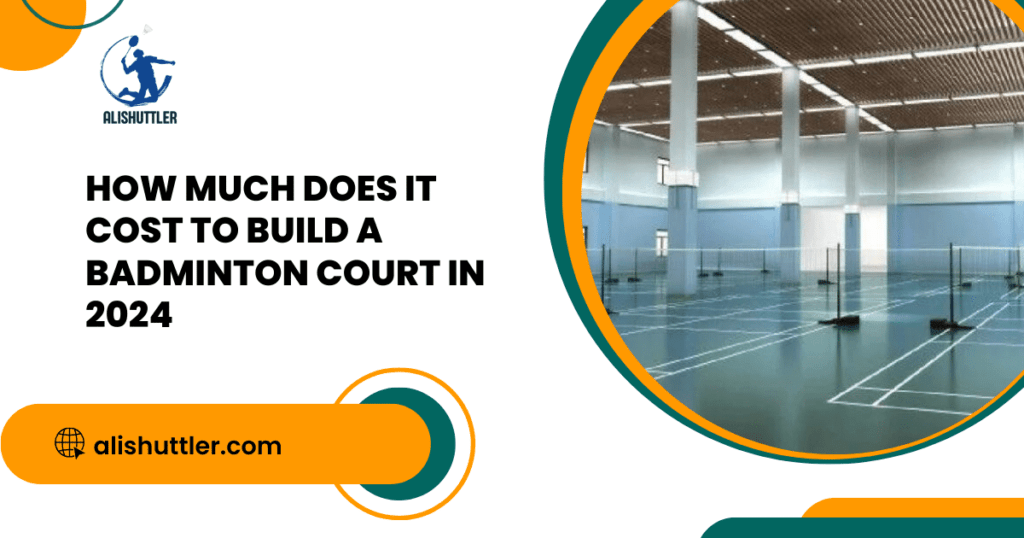Curious about how much it cost to build a badminton court in 2024? Whether you’re a sports enthusiast or an entrepreneur exploring investment opportunities, understanding the expenses involved is crucial. In this post, we’ll delve into the factors that influence the cost of constructing a badminton court. From material selection and court size to additional amenities, we’ll break down the essential elements impacting your budget. By gaining insights into these aspects, you can make informed decisions regarding your badminton court project.
Table of Contents
Current Trends in Badminton Court Costs
Impact of Rising Demand
The increasing demand for badminton courts has led to a significant impact on construction costs. As more people show interest in playing badminton, the need for additional facilities has surged. This heightened demand often results in increased prices for constructing new badminton courts. The rise in demand means that builders and suppliers can charge higher rates due to the competitive nature of securing their services.
This trend is particularly noticeable in areas where there are limited existing badminton court facilities. When there are fewer options available, individuals or organizations seeking to build new courts may face inflated expenses due to high demand and limited competition among contractors.
In some cases, the surge in popularity could also lead to an increase in land prices as potential developers compete for suitable locations to construct badminton courts.
Influence of Location
The location plays a crucial role in determining the cost of building a badminton court. Urban areas with high real estate values generally have higher construction costs compared to rural or suburban regions. In metropolitan cities, where space is at a premium, acquiring land and obtaining necessary permits can be significantly more expensive than it would be elsewhere.
Furthermore, local regulations and zoning laws can influence construction expenses by imposing specific requirements or restrictions on building materials and design choices. For example, certain areas may mandate eco-friendly features or noise-reduction measures that add extra costs to the overall project.
Moreover, accessibility and proximity to amenities such as parking lots, public transportation links, and other recreational facilities can also affect total construction outlay.
Impact of Technological Advancements
Advancements in technology have revolutionized various aspects of constructing badminton courts, impacting overall expenses. Innovative materials designed specifically for sports surfaces offer enhanced performance but often come with a higher price tag compared to traditional options like concrete or asphalt.
Technological improvements have introduced sophisticated lighting systems tailored for indoor sports facilities that provide better visibility while minimizing energy consumption. While these advancements contribute positively towards creating superior playing environments, they do add upfront costs during installation.
Key Factors Affecting Badminton Court Construction Expenses
Badminton court construction costs are significantly influenced by the size and dimensions of the court. Larger courts require more materials, such as flooring, paint, and netting, leading to higher expenses. For example, a standard singles badminton court measures 17 feet in width and 44 feet in length, while a doubles court is wider at 20 feet. A larger area means more resources for surfacing and marking out the boundaries.
Moreover, specialized equipment like fencing or lighting may be necessary for outdoor courts or large indoor facilities. These additional features contribute to increased construction expenses. Therefore, it’s crucial to consider how variations in size impact overall costs when planning a badminton court project.
The cost also depends on whether you’re constructing a new facility from scratch or renovating an existing one. Renovations may involve removing old surfaces or structures before installing new ones, which can add to the total expense due to extra labor hours required for demolition work.
Indoor vs Outdoor Badminton Court Cost Analysis

Varied Considerations
Building a badminton court indoors or outdoors involves different cost considerations. For indoor courts, factors like lighting and climate control significantly impact expenses. The need for proper lighting to ensure optimal visibility during games can increase the overall construction costs.
On the other hand, outdoor court construction may require less expenditure on lighting due to natural light availability. However, outdoor courts might need additional investments in durable materials to withstand varying weather conditions, impacting initial construction costs differently.
Maintenance Disparities
Maintenance disparities play a crucial role in determining the overall cost of building a badminton court. Indoor courts generally require more frequent maintenance due to factors such as wear and tear from increased usage and the need for continuous climate control systems.
Conversely, outdoor courts may demand less regular maintenance but could face higher repair costs due to exposure to changing weather patterns and natural elements. These disparities contribute significantly when evaluating the total cost of ownership for both types of badminton courts.
Flooring Materials and Their Impact on Costs
Cost Comparison
The choice of sports flooring material significantly impacts the overall expenses. Different materials such as wood, concrete, and synthetic options vary in terms of upfront costs. For instance, installing a wooden floor might initially cost more than using concrete or synthetic materials. However, considering long-term maintenance expenses, wood may require more frequent refinishing and upkeep compared to concrete or synthetic surfaces.
Concrete is generally less expensive to install initially but may incur higher maintenance costs over time due to cracks that could develop from wear and tear. On the other hand, synthetic flooring options like PVC or rubber can be relatively cost-effective both in installation and long-term maintenance.
Player Comfort and Performance
The influence of player comfort and performance also plays a crucial role in determining the choice of sports flooring material for a badminton court. While considering cost, it’s essential to factor in how each type of material affects players’ movements, cushioning against impact, traction control, and overall playing experience.
For example:
- Wood provides good shock absorption but may not offer adequate grip for quick lateral movements.
- Concrete can be harsh on players’ joints due to its lack of shock absorption properties.
- Synthetic materials like PVC or rubber are designed with shock-absorbing qualities while offering excellent traction control for swift movements.
Site Preparation and Subsurface Considerations
Importance of Proper Site Preparation
Proper planning and site preparation plays a crucial role in determining the overall cost of constructing a badminton court. Before commencing construction, it’s essential to ensure that the selected location is suitable for building a court. Inadequate site preparation can lead to additional expenses down the line, making it imperative to address any potential issues from the outset.
In terms of resurfacing, inadequate site preparation can result in uneven surfaces, poor drainage, or structural instability. These issues may necessitate costly repairs or modifications after construction has already begun. By investing time and resources into thorough site evaluation and preparation at the onset, unnecessary expenses can be avoided later on.
Impact of Soil Conditions and Drainage Systems
Soil conditions greatly influence construction costs when building a badminton court. The type of soil present at the chosen location will impact excavation requirements, and foundation stability, and ultimately affect overall project expenses. For instance, rocky terrain may require heavy-duty excavation equipment which increases operational costs.
Moreover, installing an effective drainage system is vital for preserving the integrity of the court surface over time. Without proper drainage systems in place, water accumulation can lead to erosion or damage to flooring materials such as asphalt or synthetic surfaces. Addressing these concerns during the initial planning stages helps prevent future expenditures related to repairing water-related damages.
Land grading also plays a significant role in controlling construction costs associated with subsurface considerations when creating a badminton court. Uneven terrain requires extensive leveling efforts which can escalate both labor and material expenses substantially.
Additional Features and Customization Options
Cost Implications
When considering additional features for a badminton court, it’s crucial to account for the potential additional costs. Amenities like spectator seating and storage areas can significantly impact the overall budget. For example, installing comfortable seating or constructing designated storage spaces may require extra materials, labor, and time.
Integrating custom design elements into the court can also influence the construction expenses. Unique flooring options, specialized lighting fixtures, or personalized color schemes might elevate the installation cost due to their specific requirements. These customizations often demand professional expertise and tailored materials, affecting both the initial quote and long-term maintenance.
Multi-Sport Capabilities
When contemplating additional features for a badminton court, one must consider its potential multi-sport capabilities. Designing a versatile space that accommodates various activities such as volleyball or basketball expands its utility but can also affect safety considerations and player experience.
For instance, incorporating adjustable net systems to facilitate different sports requires careful planning to ensure structural integrity while maintaining player safety. Modifying floor markings to accommodate multiple games demands precision in layout design to prevent confusion among players during gameplay.
Yearly Maintenance and Upkeep Expenses
Budgeting for Maintenance Costs
When considering how much it costs to build a badminton court, it’s crucial to budget for ongoing maintenance costs. This includes expenses for regular cleaning, repairs, and equipment upkeep. The annual maintenance budget should account for the wear and tear of the court surface, nets, posts, lighting systems, and any other fixtures.
Regular cleaning is essential to maintain the playing surface’s integrity and prevent safety hazards. Repairs may be necessary due to damage caused by intense gameplay or natural wear over time. Equipment upkeep involves ensuring that items such as shuttlecocks, rackets, and netting are in good condition.
It’s important to allocate funds specifically for these ongoing maintenance needs to ensure that the badminton court remains safe and enjoyable for players.
Impact of Weather Conditions
The impact of weather conditions on seasonal maintenance requirements can significantly influence maintenance costs. In areas with harsh winters or heavy rainfall seasons, special attention must be given to addressing weather-related damages such as cracks in the court surface or water damage.
In contrast, courts located in more temperate climates might experience less severe weather-related wear-and-tear issues but still require routine inspections after periods of heavy use during peak playing seasons.
The need for additional care during specific times of the year due to varying weather conditions can affect how much is spent annually on maintaining a badminton court.
Importance of Regular Inspections
Regular inspections play a critical role in managing long-term maintenance expenditures. By identifying small issues early through consistent inspections, larger repair problems can often be avoided — saving both time and money.
For example:
- Identifying small cracks on the court surface before they worsen could prevent costly resurfacing projects.
- Routine checks on lighting systems can catch minor electrical issues before they become major repair needs.
- Inspecting nets and posts regularly helps maintain player safety while preventing unexpected replacement costs down the line.
By proactively monitoring all aspects of the badminton court through regular inspections throughout each year, owners can effectively manage their long-term maintenance budgets.
Funding and Financing Options for Court Construction
Grants and Sponsorships
Seeking grants and sponsorships can significantly alleviate the financial burden. Many sports organizations, local government initiatives, or even private companies offer grants to support the development of sports facilities. These funds can cover a substantial portion of the construction costs, making it more feasible for communities or organizations with limited resources to build a badminton court.

Grants are essentially free money that does not need to be repaid, while sponsorships involve partnerships with businesses or individuals who provide financial support in exchange for recognition or advertising opportunities. For instance, a local business might sponsor the construction of a badminton court in return for having their logo displayed at the facility or mentioned in promotional materials. By securing grants and sponsorships, communities and sports organizations can make significant progress towards realizing their goal of building a badminton court without shouldering all expenses themselves.
Community Partnerships
In addition to grants and sponsorships, forging community partnerships is another effective way to finance court construction. Collaborating with local schools, recreation centers, or other sports facilities can lead to cost-sharing arrangements where multiple entities contribute financially towards building a shared badminton court. This approach not only diversifies funding sources but also fosters stronger community ties by involving various stakeholders in supporting recreational infrastructure projects.
Moreover, leveraging existing relationships within the community can open doors for obtaining discounted materials or labor services from local businesses. For example, partnering with a nearby construction company may result in receiving preferential rates on building supplies or reduced labor costs for constructing the court. Through strategic collaboration and resource pooling within the community, financing options become more accessible while promoting collective investment in enhancing recreational amenities.
Initiating Your Badminton Court Project: Steps and Tips
Feasibility Studies
Before diving into the cost of building a badminton court, it’s crucial to conduct thorough feasibility studies. These studies help in determining if the project is viable and what potential challenges might arise. They involve analyzing factors like location, target audience, and competition. For example, you need to assess whether there’s enough demand for a badminton court in your chosen area.
Feasibility studies also consider financial aspects such as construction costs and ongoing operational expenses. By conducting these studies at the outset, you can gain valuable insights that will influence your budget planning process.
When looking at sites for your badminton court project, ensure they are easily accessible to your target audience. Consider factors like proximity to residential areas or schools where players might come from.
Engaging with Professionals
Engaging with architects, contractors, and legal authorities is an essential part of initiating a badminton court project. Architects can help design the layout of the court while ensuring it meets regulatory standards. Contractors will provide estimates for construction costs based on the desired specifications.
Legal authorities play a key role in obtaining necessary permits for construction. It’s important to work closely with them to ensure all legal requirements are met before breaking ground on the project.
In addition to professionals directly involved in construction, consider engaging with local sports organizations or badminton clubs who may offer valuable insights into what makes a successful facility.
Permit Process Navigation
Navigating through permit processes can be complex but is crucial when building a badminton court. This involves acquiring various approvals from local government bodies related to land use and zoning regulations.
Securing funding for your project is another vital step during initiation. Whether through private investors or grants from sports organizations or governmental bodies – securing adequate funds will determine whether your vision becomes reality.
Closing Thoughts on How Much It Cost to Build a Badminton Court in 2024
You’ve now got a good grip on the costs involved in building a badminton court. From the current trends to the factors affecting construction expenses, we’ve covered it all. Now, armed with this knowledge, you can make informed decisions when planning your badminton court project. Whether it’s choosing between indoor and outdoor courts, selecting the right flooring materials, or considering maintenance expenses, you’re well-prepared to tackle it all. So, go ahead and take the plunge into building your dream badminton court!

Remember, while costs are essential, don’t forget the joy and excitement that comes with playing on your court. It’s not just about the money; it’s about creating a space where memories are made and skills are honed. So, use this information wisely and get ready to smash your way into the world of badminton!
Frequently Asked Questions
How much does it cost to build a badminton court?
The cost of building a badminton court can vary widely based on factors such as location, materials used, and additional features. On average, indoor courts may range from $50,000 to $100,000 while outdoor courts could cost between $20,000 to $30,000.
What are the key factors affecting badminton court construction expenses?
Factors like location, size of the court, choice of flooring material (such as wood or synthetic), site preparation requirements (like grading and drainage), and customization options significantly impact the overall construction costs.
What is the difference in cost between indoor and outdoor badminton courts?
Indoor courts generally require higher investment due to factors like climate control systems and specialized flooring. Outdoor courts tend to be more affordable but may still incur expenses for durable weather-resistant materials.
Which flooring materials have the most impact on costs?
Wooden flooring tends to be more expensive due to its natural properties and maintenance needs. Synthetic materials like PVC or polypropylene offer durability at a lower initial cost but may require periodic replacement over time.
What are some funding and financing options for court construction?
Seeking sponsorships from local businesses or sports organizations can help offset costs. Exploring grants specifically allocated for sports facility development or approaching financial institutions for loans tailored toward community projects can provide viable funding avenues.

